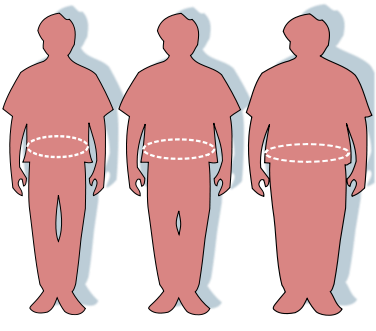What is obesity?
Obesity is a medical condition in which excess body fat has accumulated to the extent that it may result in increased health problems and reduced life expectancy. As central obesity (excess ectopic fat stored around major organs and abdomen) is the most dangerous form to health, waist measurement can be a key indicator of risk. Generally, men with a waist circumference of 94cm or more (and women of 80cm or more) are more likely to develop obesity-related health problems.

Illustration of obesity and waist circumference From left to right, as labeled in the original image, the "healthy" man has a 33 inch (84 cm) waist, the "overweight" man a 45 inch (114 cm) waist, and the "obese" man a 60 inch (152cm) waist. (image source) (image reference) Source: Report of the Dietary Guidelines Advisory Committee on the Dietary Guidelines for Americans, 2000. Infographic: FDA/Renée Gordon / Wikipedia
Body Mass Index (BMI) is also used as an indicator of healthy weight for height (although people who are very muscular can have a high BMI, without excess fat). For most adults:
- a BMI of 25 to 29.9 is considered overweight;
- a BMI of 30 to 39.9 is considered obese; and,
- a BMI of 40 or above is considered severely obese.
Older patients, in particular, may have a normal BMI while having a waist measurement which places them into the high risk category.
The Royal College of Physicians [4] notes that:
- Obesity is strongly heritable (60% of weight variance is attributed to heredity) yet currently known gene mutations and polymorphisms account for <5% of weight variability.
- Diagnosis by BMI requires measuring height and weight accurately; risk stratification in overweight and modest obesity requires measuring waist circumference and possibly the use of a clinical staging system (Edmonton Obesity Staging System (EOSS)).
- Prevention and long-term weight loss maintenance require sustained changes in diet and physical activity habits.
- Obesity is a major risk factor in diabetes (5 x), cancer (3 x the risk of colon cancer), and heart disease (2.5 x).
- Modest weight loss (~10 kg) helps to improve diabetes, improves quality of life and reduces morbidity.
- An energy deficit of only 100 calories per day predicts a 0.5 kg weight loss in a month.
- Cost-effective treatments in appropriate patients include weight loss programmes (commercial: e.g. WeightWatchers; GP delivered: eg Counterweight); pharmacotherapy (egorlistat); and bariatric surgery.